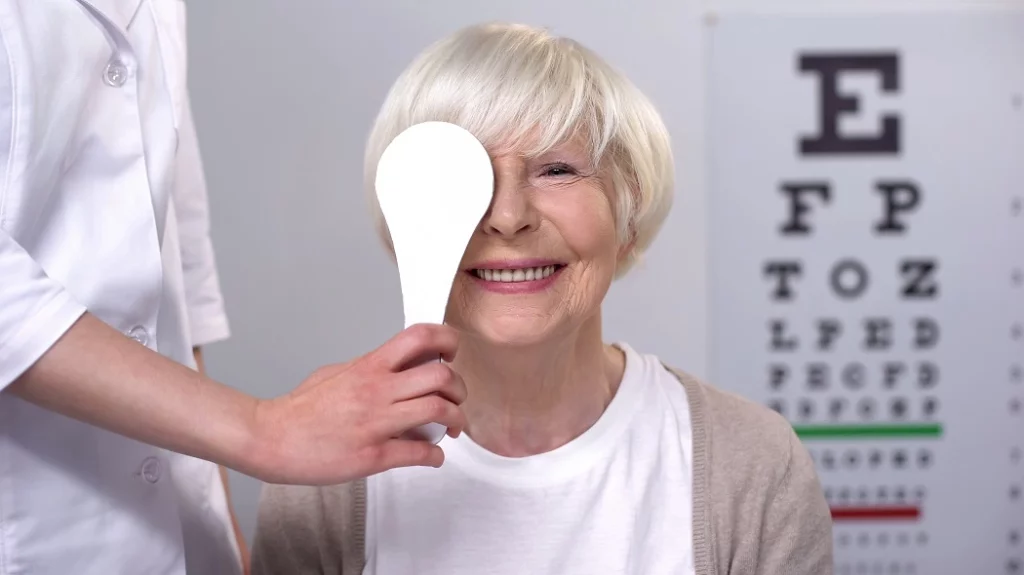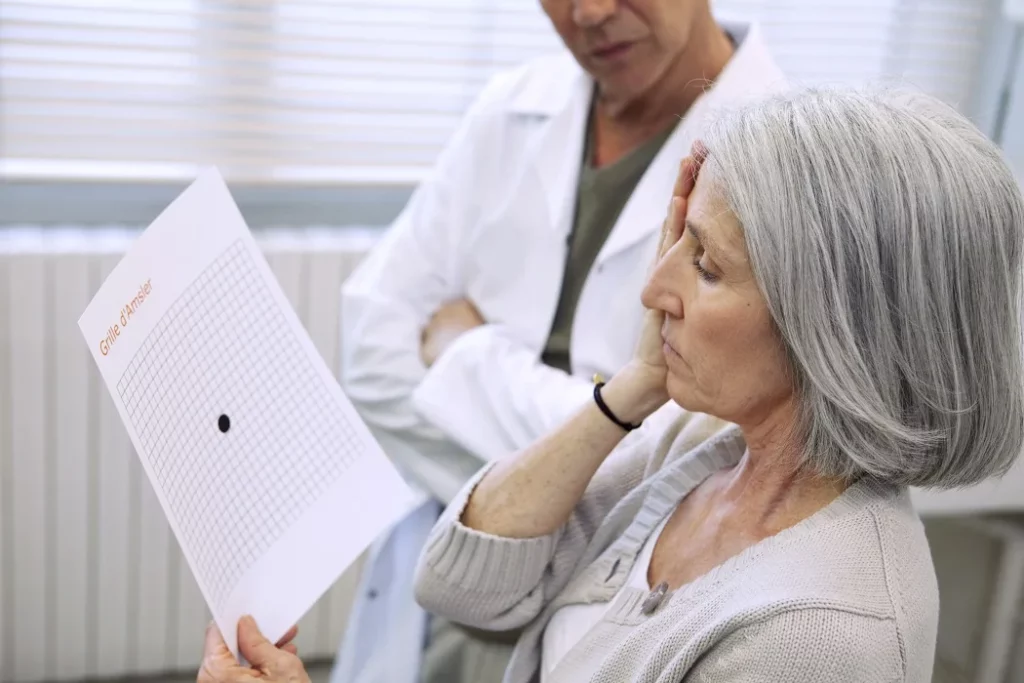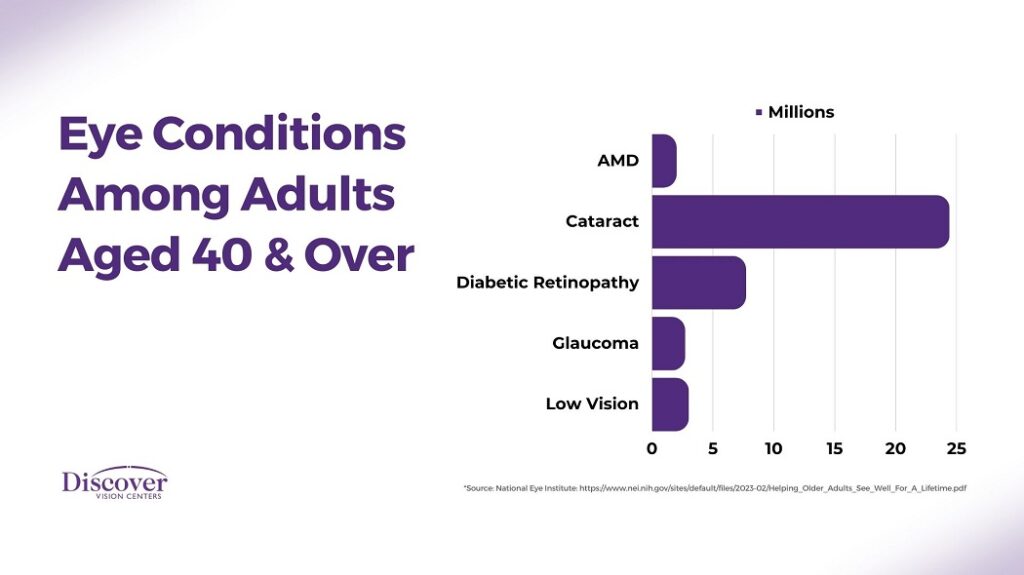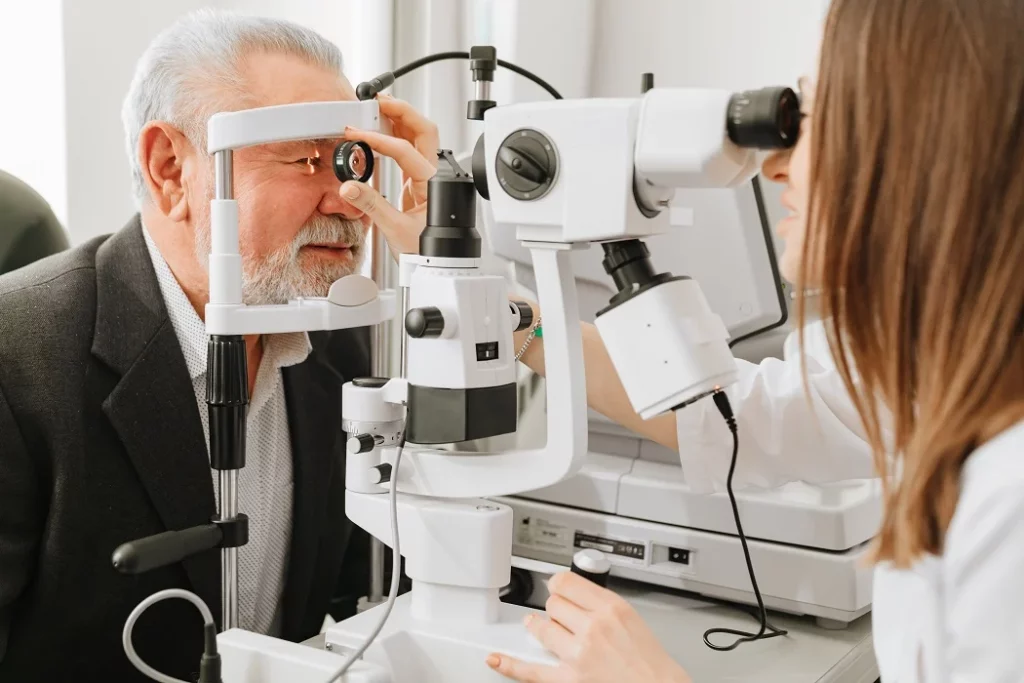
Updated: December 01, 2023

As we age, our eyes age and require special attention to maintain optimal health. In this blog, we’ll explore essential strategies and habits for preserving your vision as the years pass. From incorporating eye-friendly nutrients into your diet to adopting smart lifestyle practices and scheduling regular eye exams, we’ll cover a range of proactive measures to safeguard your eyesight. Discover practical tips and expert advice on how to prioritize your senior eye health, ensuring a clear and vibrant view of the world as you navigate the golden years of life.
Exploring the world of age-related eye issues, this blog delves into common concerns like eye floaters, dry eyes, AMD, cataracts, glaucoma, and retinal disorders. Understanding these conditions is key to proactive eye care as we navigate the journey of aging.
As we age, eye floaters become more common, appearing as tiny specks or cobweb-like shapes drifting across our vision. While usually harmless, persistent floaters may signal retinal issues. Regular eye check-ups are essential to monitor changes. If you notice a sudden increase in floaters or flashes of light, consult an eye care professional promptly to rule out any serious conditions.
Age-related dry eyes are a common concern as tear production decreases over time. This can lead to irritation, blurred vision, and discomfort. Factors like hormonal changes and environmental conditions exacerbate the issue. Managing dry eyes involves using artificial tears, maintaining proper eye hygiene, and staying hydrated. Regular eye check-ups help identify underlying causes, ensuring tailored solutions for relief. Don’t dismiss persistent dryness – proactive care is key to maintaining comfort and clarity as we age.

Age-related Macular Degeneration (AMD) is a progressive eye condition affecting the macula, impairing central vision. As we age, the risk increases. Early stages may go unnoticed, but symptoms like distorted vision or blind spots can emerge. Regular eye exams are crucial for early detection. Lifestyle changes, nutritional supplements, and advanced treatments may slow progression. Awareness and proactive measures are essential to safeguard vision, making AMD a significant consideration in comprehensive eye care for aging individuals.
Cataracts, a common age-related issue, occur when the eye’s lens becomes cloudy, impacting vision. Over time, this cloudiness worsens, leading to blurred vision and increased sensitivity to light. Aging is a primary factor, but genetics and environmental factors play roles. Cataract surgery, a routine, and highly successful procedure involves replacing the cloudy lens with an artificial one. Regular eye check-ups help monitor cataract development and other elderly eye disease, ensuring timely intervention and maintaining clear vision as we age.
Glaucoma, a progressive eye condition, becomes more prevalent as we age, often with no early symptoms. It damages the optic nerve, impacting peripheral vision and potentially leading to blindness. Regular eye exams are crucial for early detection and management. Elevated intraocular pressure is a risk factor, but glaucoma can develop at normal levels too. Treatment aims to lower pressure and preserve vision. As an age-related concern, awareness, and proactive monitoring are vital to minimizing the impact of glaucoma on aging eyes.
As we age, the risk of retinal disorders like diabetic retinopathy, retinal tears/detachment, and corneal disease increases. Diabetic retinopathy affects blood vessels, while retinal tears/detachment impact vision. Corneal diseases may cause discomfort and affect clarity. Regular eye exams are vital for early detection and tailored interventions. Lifestyle choices, genetics, and diabetes management influence these disorders. Timely treatment, often involving laser therapy or surgery, is crucial for maintaining visual health and preventing complications associated with aging eyes.
Age-related eyelid issues, particularly droopy eyelids, can impact both appearance and vision. Over time, skin loses elasticity, causing eyelids to sag. This can obstruct vision and contribute to a tired appearance. Factors like genetics and sun exposure play roles. Surgical options, such as blepharoplasty, are effective for rejuvenation. However, regular eye check-ups help monitor changes and address concerns. Managing eyelid issues is essential for maintaining clear vision and a youthful look as we navigate the aging process.

Discover ten practical tips for maintaining optimal eye health in this insightful blog. From proper nutrition to eye-friendly habits, tips on vision care for seniors, these suggestions will empower you to safeguard your vision and enjoy a lifetime of clear and vibrant eyesight.
Scheduling annual eye exams is crucial for monitoring eye health. Regular check-ups allow for early detection of potential issues, ensuring timely intervention to preserve clear vision and overall eye well-being.
Scheduling an annual eye exam is paramount for maintaining optimal eye health. These exams go beyond assessing visual acuity; they also allow professionals to monitor the overall health of your eyes. Early detection of conditions like glaucoma, cataracts, or macular degeneration is crucial for effective intervention. Regular eye exams ensure your prescription is up-to-date, reducing eye strain. Prioritizing this annual check-up is a proactive step toward preserving your vision and addressing any potential issues before they become more serious.
As we age, protecting our eyes from harmful UV rays becomes increasingly important. Prolonged exposure can contribute to cataracts and age-related macular degeneration. Choose sunglasses that provide 100% UV protection to shield your eyes from these risks. This simple precautionary measure not only safeguards your vision but also promotes long-term eye health, allowing you to enjoy clear and vibrant eyesight as you navigate the aging process.
Reducing screen time has a profound impact on eye health. Extended digital device use can lead to digital eye strain, causing discomfort and visual disturbances. Following the 20-20-20 rule – looking at something 20 feet away for 20 seconds every 20 minutes – alleviates strain. Limiting screen exposure fosters healthier eyes, reducing the risk of conditions associated with prolonged device use and ensuring overall visual well-being.

Maintaining a balanced diet is crucial for eye health as we age. Foods rich in vitamins A, C, E, and omega-3 fatty acids contribute to optimal vision. Leafy greens, fish, and colorful fruits protect against age-related macular degeneration and promote overall eye well-being. A nutrient-rich diet is a proactive measure to support your eyes and sustain clear vision throughout the aging process.
Adequate sleep is essential for maintaining optimal eye health as we age. Insufficient rest can lead to dry eyes, eye spasms, and blurred vision. Quality sleep allows your eyes to recover, reducing discomfort and promoting overall visual well-being. Prioritizing sufficient, restful sleep is a simple yet effective way to support your eyes and ensure they function optimally throughout the aging process.
As we age, using ample light indoors is crucial for preserving eye health. Proper lighting reduces eye strain, especially during close-up tasks. Ensure well-lit spaces for reading and work, minimizing glare and discomfort. Position light sources strategically to create well-lit environments, promoting clearer vision and mitigating the impact of aging on eye comfort and functionality.
Giving your eyes a break is essential for maintaining eye health as you age. Regular breaks during extended periods of focused work or screen time prevent eye fatigue. Following the 20-20-20 rule – looking at something 20 feet away for 20 seconds every 20 minutes – reduces strain and keeps your eyes moist. Prioritize these breaks to alleviate discomfort, ensuring your eyes function optimally throughout the aging process.
Regular exercise contributes significantly to eye health as we age. Physical activity enhances overall well-being, improving blood circulation to the eyes. Incorporating exercise into your routine is a proactive step toward preserving visual health, supporting the longevity and functionality of your eyes as you navigate the aging process.
Ceasing smoking is crucial for maintaining eye health as we age. Smoking is a significant risk factor for eye diseases like cataracts and macular degeneration. Quitting smoking reduces these risks and supports overall eye well-being. By eliminating this habit, you enhance your chances of preserving clear vision and preventing complications associated with aging eyes, promoting a healthier and brighter visual future.

Are you actively involved in the healthcare of a parent or someone who is close to you? Encouraging an older family member to consult an eye specialist is a proactive step toward their overall well-being. Gently emphasize the importance of regular eye check-ups. Age-related vision changes can be detected early and effectively managed. Highlight the potential improvements in their daily life with clear and comfortable vision. Offer your support by accompanying them to appointments, addressing any concerns, and ensuring they receive personalized care. Prioritizing eye health fosters a higher quality of life, making the decision to consult an eye specialist a wise and caring choice.
Low vision is when someone’s eyesight isn’t as clear or sharp as most people’s. Imagine trying to see things, and they look blurry or not as bright. It’s like looking through foggy glasses all the time, making it harder to see and do some things. People with low vision may use special tools or techniques to help them see better and do the things they enjoy.
After 65, it is generally recommended to have comprehensive eye exams annually. Regular check-ups help monitor changes in vision, detect age-related issues early, and ensure timely intervention for optimal eye health.
Medicare is an eye care insurance for seniors that are 65 or older. It generally covers eye-related services deemed medically necessary, such as cataract surgery or treatment for certain eye diseases. However, routine eye exams for glasses or contact lenses are typically not covered. Supplemental plans may offer additional vision benefits. It’s crucial to check Medicare guidelines and plan details for specific coverage information.
We are closed Monday (05/25)! Urgent Care is also closed Saturday (05/23)!
We are closed Friday (07/03)!
We are closed Monday (09/07)! Urgent Care is also closed Saturday (09/05)!
We are closed Thursday (11/26) and Friday (11/27)! Urgent Care is also closed Saturday (11/28)!
We are closed Wednesday (12/24) and Thursday (12/25)! We are closed 1/2 Day Wednesday (12/31). We are closed Thursday (01/01).